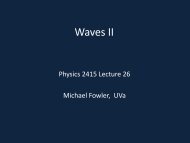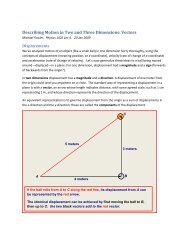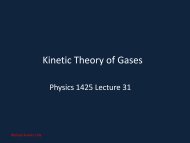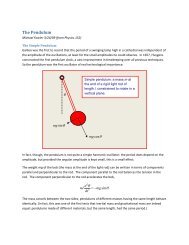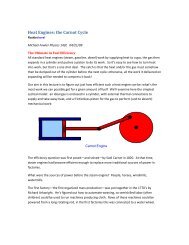Thermal Expansion Coefficients - Galileo and Einstein
Thermal Expansion Coefficients - Galileo and Einstein
Thermal Expansion Coefficients - Galileo and Einstein
- No tags were found...
Create successful ePaper yourself
Turn your PDF publications into a flip-book with our unique Google optimized e-Paper software.
6These simple ratios of interacting gases could be understood if one imagined the atoms combining toform molecules, <strong>and</strong> made the further assumption, known as Avogadro’s Hypothesis (1811):Equal volumes of gases at the same temperature <strong>and</strong> pressure containthe same number of molecules.One could then underst<strong>and</strong> the simple volume results by assuming the gases were made of diatomicmolecules, H 2 , N 2 , O 2 <strong>and</strong> the chemical reactions were just molecular recombinations given by theequations N 2 + O 2 = 2NO, 2H 2 + O 2 = 2H 2 O, etc.Of course, in 1811 Avogadro didn’t have the slightest idea what this number of molecules was for, say,one liter, <strong>and</strong> nobody else did either, for another fifty years. So no-one knew what an atom or moleculeweighed, but assuming that chemical reactions were atoms combining into molecules, or rearrangingfrom one molecular pairing or grouping to another, they could figure out the relative weights of atoms,such as an oxygen atom had mass 16 times that of a hydrogen atom—even though they had no ideahow big these masses were!This observation led to defining the natural mass of a gas for setting the value of the constant C in thegas law to be a “mole” of gas: hydrogen was known to be H 2 molecules, so a mole of hydrogen was 2grams, oxygen was O 2 , so a mole of oxygen was 32 grams, <strong>and</strong> so on.With this definition, a mole of oxygen contains the same number of molecules as a mole of hydrogen: soat the same temperature <strong>and</strong> pressure, they will occupy the same volume. At 0C, <strong>and</strong> atmosphericpressure, the volume is 22.4 liters.So, for one mole of a gas (for example, two grams of hydrogen), we set the constant C equal to R,known as the universal gas constant, that is PV = RT withR = 8.3 J/(mol.K) .For n moles of a gas, such as 2n grams of hydrogen, the law is:<strong>and</strong> this is the st<strong>and</strong>ard form of the Gas Law.PV = nRTWe now know, of course, that Avogadro’s number is 6.02×10 23 molecules per mole.(Footnote: after the discovery of isotopes, nuclei of the same element having different masses, <strong>and</strong> inparticular of a form of hydrogen called heavy hydrogen present in small quantities in nature, thedefinition of the mole was refined to be equal to precisely 12 grams of the carbon isotope C 12 . Inpractice, this is a tiny correction which doesn’t affect anything we’ve said here.)





